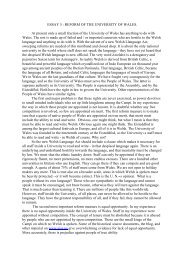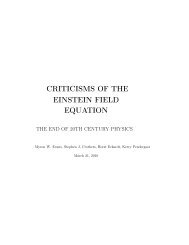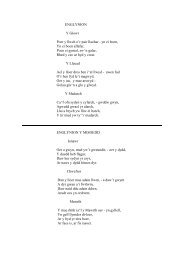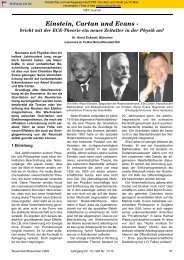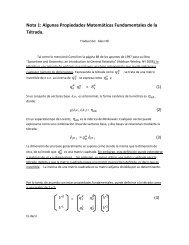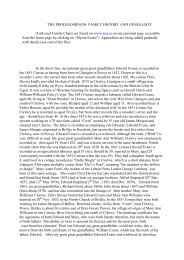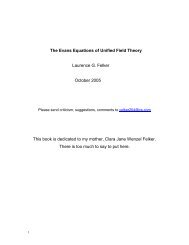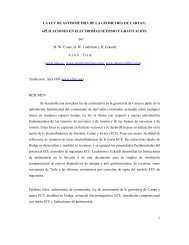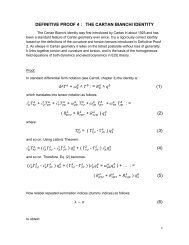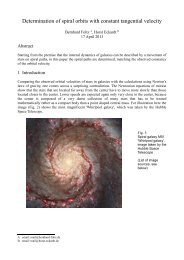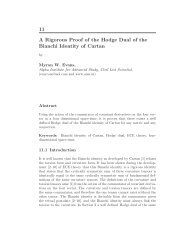Spin Connection Resonance in the Bedini Machine - Alpha Institute ...
Spin Connection Resonance in the Bedini Machine - Alpha Institute ...
Spin Connection Resonance in the Bedini Machine - Alpha Institute ...
You also want an ePaper? Increase the reach of your titles
YUMPU automatically turns print PDFs into web optimized ePapers that Google loves.
22 1 <strong>Sp<strong>in</strong></strong> <strong>Connection</strong> <strong>Resonance</strong> <strong>in</strong> <strong>the</strong> Bed<strong>in</strong>i Mach<strong>in</strong>e<br />
a spike pulse of one percent of <strong>the</strong> time period. Fig. 1.9 shows <strong>the</strong> result for<br />
a constant value of f2.<br />
S<strong>in</strong>ce <strong>the</strong> zero cross<strong>in</strong>g of Ar is essential for <strong>the</strong> resonances, we have modified<br />
Eq. (1.85) by add<strong>in</strong>g a constant value of 0.001, thus displac<strong>in</strong>g <strong>the</strong> curve<br />
of Fig. 1.3 by this value from zero. The result (Fig. 1.10) shows a far smaller<br />
resonance structure <strong>in</strong>dicat<strong>in</strong>g that resonances are very sensitive to <strong>the</strong> form<br />
of Ar via ω0.<br />
Next we <strong>in</strong>spect <strong>the</strong> development of <strong>the</strong> maximum amplitude. In Fig. 1.11<br />
<strong>the</strong> maximum difference over <strong>the</strong> first six time periods is plotted <strong>in</strong> dependence<br />
of <strong>the</strong> time frequency. Obviously <strong>the</strong> resonance is most dramatic for low<br />
frequencies. In <strong>the</strong> next figure (Fig. 1.12) <strong>the</strong> maximum amplitude difference<br />
was recorded over a constant simulated time of 0.1 sec. To avoid numerical<br />
<strong>in</strong>stabilities <strong>in</strong>ferred by <strong>the</strong> calculation we used a modified Ar <strong>in</strong>put value as<br />
discussed for Fig. 1.10 (shifted by 0.1 upwards, no zero cross<strong>in</strong>g). Solutions<br />
are stable <strong>in</strong> <strong>the</strong> low frequency range but <strong>the</strong>re are w<strong>in</strong>dows of unstability for<br />
higher frequencies. We argue that <strong>the</strong> differential equation (1.78) can show<br />
chaotic behaviour and must be carefully evaluated.<br />
F<strong>in</strong>ally we present <strong>the</strong> amount of transferred energy <strong>in</strong>tegrated over time.<br />
Accord<strong>in</strong>g to Eq. (1.76) this is proportional to<br />
t<br />
u(t) =<br />
0<br />
A 2 ϕ(t ′ )<br />
ω dt′ . (1.88)<br />
This term is represented <strong>in</strong> Fig. 1.13. S<strong>in</strong>ce Aϕ crosses zero at <strong>the</strong> resonances<br />
(remember that <strong>the</strong> modulus is shown <strong>in</strong> <strong>the</strong> figures), a considerable amount<br />
of energy is pushed back to <strong>the</strong> vacuum after hav<strong>in</strong>g been transferred to <strong>the</strong><br />
system, but <strong>the</strong>re is enough energy left after each resonance peak so that <strong>the</strong><br />
energy <strong>in</strong> <strong>the</strong> system rises considerably.<br />
As a last item <strong>in</strong> this section let us consider <strong>the</strong> radius dependence of <strong>the</strong><br />
fields which can not be determ<strong>in</strong>ed from Eqs. (1.77–1.79) as discussed above.<br />
Therefore let’s start from Eqs. (1.77) and (1.80):<br />
Är +˙ω0Ar + ω0 ˙<br />
Ar = −f1<br />
<br />
Ar<br />
˙ + ω0 + r ∂ω0<br />
<br />
∂Ar ˙ ∂Ar<br />
Ar + r + rω0<br />
∂r ∂r ∂r<br />
(1.89)<br />
= 0 (1.90)<br />
We will make an ansatz for Ar and compute <strong>the</strong> solution for ω0 which is<br />
compatible with this. We choose<br />
Ar = Ce −αr−iβt<br />
(1.91)



